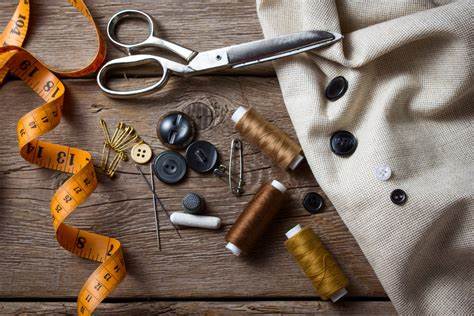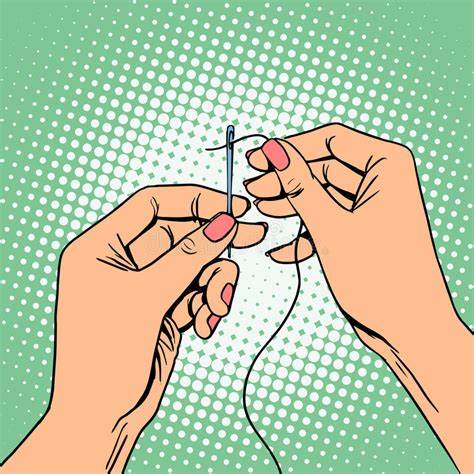
Sustainable Fashion has a ton of cool and inspiring aspects like fair trade, buying local, choosing natural fibers, buying second-hand, up-cycling and recycling. One pretty basic component in sustainable fashion which hasn’t gotten the hype it deserves, at least until now in France, is the art and joy of maintaining.
A hundred years ago, actually up until immediately after WWII, it was normal for us to repair our clothes. Indeed, even First Lady Eleanor Roosevelt wore mended nylons. I know this because my grandmother loved to tell the story of sitting in the first row of a lecture hall, listening to a panel which included Mrs. Roosevelt. My grandmother was sitting close enough to Eleanor to notice that her nylon stockings were hand-mended.
But today most people don’t go to cobblers or tailors, or know how to hem a skirt or mend a hole in their sweater. Considering that on average we discard our clothes after only seven wears (this shocks me because I have clothes I’ve worn for 30 years) I wonder how many of us today have ever replaced a button. Worse still, it’s difficult to make a living as a professional shoe cobbler or tailor today, and those businesses and skill sets are disappearing from our culture.
Those French are on to Something
To help reverse the trend of fast fashion and save our planet from landfills overflowing with discarded, perfectly reparable clothes, the French government decided to pay people to keep their clothes and shoes in good condition. Really.
Starting in October, France will give subsidies to shoe-repair shops and tailors, to be passed on to clients, in order to encourage people to maintain rather than replace their shoes and clothing. The project aims to significantly reduce the 700,000 tons of clothes French citizens throw away each year, most of which end up in landfills, and promote sustainable fashion awareness.
Specifically, this policy offers customers a 7 euro discount ($7.87) for repairing a heel and 10 to 25 euros (or $11.24 to $28.10) for clothing repairs, supported by a 154 million euro fund to cover costs from 2023 through 2028. The project is part of a larger policy initiated in 2022 to reform the textile industry and mitigate the harmful effects of fast fashion in France. Here’s a short clip in French taken from FranceInfo Evening News on July 12 explaining how the project will work:
Pouvoir d’achat : le gouvernement prévoit la mise en place d’un bonus réparation textile d’ici octobre:
Even Without the Subsidy, this Makes Sense for Us Too
Until a flying pig drops leaflets at our doorsteps announcing that our government is going to pay us to alter that skirt or repair that stiletto, why should we also be encouraged to follow suit and look up the address of the nearest cobbler? Three answers – The planet, our wallet and a better wardrobe.
- The Planet. As I outline in my Shop Used! blog, it’s abundantly clear that fast fashion is seriously damaging our planet.. Clothing production is responsible for 10% of all carbon emissions, it’s the second-largest consumer of the world’s water supply and pollutes the oceans with micro-plastics. Yikes! The Environmental Protection Agency reported in 2015 that Americans sent 10.5 million tons of textiles (the majority of it clothing) to landfills that year. And, just in case you’re not horrified yet, most clothing today contains synthetics which are not biodegradable. Those synthetics are petrol based, contain plastic particles and seep into our soil, our water and our food. We need to stop buying so many clothes.
- Our Wallet. It costs on average $12 to hem a skirt at a dry cleaner/tailor. I learned how to hem a skirt in a summer sewing class when I was ten years old, so it costs me nothing but about 30 minutes of my time to measure, fold, iron, pin and stitch. Depending on the design it can cost between $10 – $20 to take in or let out a waste band or a side seam — I do pay for that because my sewing skills don’t include darts or pleats. If you have a skirt you love, why not pay a small sum to improve or maintain it and save yourself the larger sum of a new skirt? A quick Internet search will give you links to countless videos on how to mend — the invisible stitch takes a couple minutes to master, and it works on holes in jeans as well as a cashmere cardigan. Try it, you will love it!
- A better wardrobe. You will enjoy your clothes more if they fit properly and are well maintained. If you have a pair of shoes you love, why wouldn’t you want them to last longer with a polish and new sole? And mending yourself or having a tailor alter your clothes will encourage several other good habits – buying natural fibers (they last longer, are easier to repair and won’t seep poison into the soil once they are, eventually, in that landfill); washing in cold water (lower carbon footprint and easier on your clothes) and wearing clothes that fit you perfectly (seamstresses and tailors are great for that). Oh là là indeed!
In short, maintaining our clothes for more than seven wears is a tiny, painless and possibly enjoyable step that we all can take to help Save Our World.


Love this – everyone should have a sewing box! Makes sense –
Right now I’m repurposing 35 year old curtains!
Oh I can’t wait to hear what you do with the curtains!